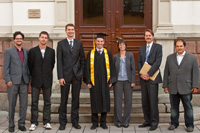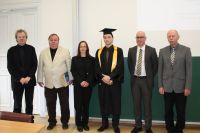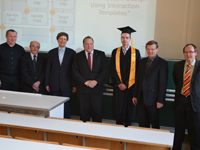| 2026 | 2025 | 2024 | 2023 | 2022 | 2021 | 2020 | 2019 | 2018 | 2017 | 2016 | 2015 | 2014 | 2013 | 2012 | 2011 | 2010 | 2009 | 2008 | 2007 | 2006 | 2005 | 2004 | 2003 | 2002 | 2001 | 2000 | 1999 | 1998 | 1997 |
Promotionen der Fakultät für Informatik im Jahr 2012
|
Kienel, Enrico Gutachter: Prof. Dr. Guido Brunnett (Technische Universität Chemnitz), Prof. Dr. Gerik Scheuermann (Universität Leipzig) |
|
| Abstract deutsch: Die vorliegende Arbeit befasst sich mit Algorithmen aus dem Bereich der Bildsegmentierung sowie der Datensynthese für das so genannte Hologrammdruck-Prinzip. Angelehnt an ein anatomisch motiviertes Forschungsprojekt werden aktive Konturen zur halbautomatischen Segmentierung digitalisierter histologischer Schnitte herangezogen. Die besondere Herausforderung liegt dabei in der Entwicklung von verschiedenen Ansätzen, die der Anpassung des Verfahrens für sehr große Bilder dienen, welche in diesem Kontext eine Größe von einigen hundert Megapixel erreichen können. Unter dem Aspekt der größtmöglichen Effizienz, jedoch mit der Beschränkung auf die Verwendung von Consumer-Hardware, werden Ideen vorgestellt, welche eine auf aktiven Konturen basierende Segmentierung bei derartigen Bildgrößen erstmals ermöglichen sowie zur Beschleunigung und Reduktion des Speicheraufwandes beitragen. Darüber hinaus wurde das Verfahren um ein intuitives Werkzeug erweitert, das eine interaktive lokale Korrektur der finalen Kontur gestattet und damit die Praxistauglichkeit der Methode maßgeblich erhöht. Der zweite Teil der Arbeit beschäftigt sich mit einem Druckprinzip für die Herstellung von Hologrammen, basierend auf virtuellen Abbildungsgegenständen. Der Hologrammdruck, der namentlich an die Arbeitsweise eines Tintenstrahldruckers erinnern soll, benötigt dazu spezielle diskrete Bilddaten, die als Elementarhologramme bezeichnet werden. Diese tragen die visuelle Information verschiedener Blickrichtungen durch einen festen geometrischen Ort auf der Hologrammebene. Ein vollständiges, aus vielen Elementarhologrammen zusammengesetztes Hologramm erzeugt dabei ein erhebliches Datenvolumen, das parameterabhängig schnell im Terabyte-Bereich liegen kann. Zwei unabhängige Algorithmen zur Erzeugung geeignet aufbereiteter Daten unter intensiver Ausnutzung von Standard-Graphikhardware werden präsentiert, hinsichtlich ihrer Berechnungs- sowie Speicherkomplexität verglichen und unter Berücksichtigung von Qualitätsaspekten bewertet. |
|
|
Kürsten, Jens Gutachter: Prof. Dr. Maximilian Eibl (Technische Universität Chemnitz), Prof. Dr. Vivien Petras (Humboldt-Universität zu Berlin), Prof. Dr. Harald Kosch (Universität Passau) |
|
|
Abstract englisch: In the past two decades international campaigns, like the Text Retrieval Conference, have led to huge advances in the design of experimental information retrieval evaluations. But in general the focus of this system-driven paradigm remained on the comparison of system results, i.e. retrieval systems are treated as black boxes. This approach to the evaluation of retrieval system has been criticised for treating systems as black boxes. Recent works on this subject have proposed the study of the system configurations and their individual components. This thesis proposes a generic approach to the evaluation of retrieval systems at the component-level. The focus of the thesis at hand is on the key components that are needed to address typical ad-hoc search tasks, like finding books on a particular topic in a large set of library records. A central approach in this work is the further development of the Xtrieval framework by the integration of widely-used IR toolkits in order to eliminate the limitations of individual tools. Strong empirical results at international campaigns that provided various types of evaluation tasks confirm both the validity of this approach and the flexibility of the Xtrieval framework. Modern information retrieval systems contain various components that are important for solving particular subtasks of the retrieval process. This thesis illustrates the detailed analysis of important system components needed to address ad-hoc retrieval tasks. Here, the design and implementation of the Xtrieval framework offers a variety of approaches for flexible system configurations. Xtrieval has been designed as an open system and allows the integration of further components and tools as well as addressing search tasks other than ad-hoc retrieval. This approach ensures that it is possible to conduct automated component-level evaluation of retrieval approaches. Both the scale and impact of these possibilities for the evaluation of retrieval systems are demonstrated by the design of an empirical experiment that covers more than 13,000 individual system configurations. This experimental set-up is tested on four test collections for ad-hoc search. The results of this experiment are manifold. For instance, particular implementations of ranking models fail systematically on all tested collections. The exploratory analysis of the ranking models empirically confirms the relationships between different implementations of models that share theoretical foundations. The obtained results also suggest that the impact on retrieval effectiveness of most instances of IR system components depends on the test collections that are being used for evaluation. Due to the scale of the designed component-level evaluation experiment, not all possible interactions of the system component under examination could be analysed in this work. For this reason the resulting data set will be made publicly available to the entire research community. |
|

|
|
|
Heil, Andreas Gutachter: Prof. Dr. Martin Gaedke (Technische Universität Chemnitz), Prof. Dr. Wolfram Hardt (Technische Universität Chemnitz) |
|
|
|
|
|
Hofmann, Michael Gutachter: Prof. Dr. Gudula Rünger (Technische Universität Chemnitz), Prof. Dr. Felix Wolf (Rheinisch-Westfälische Technische Hochschule Aachen) |
|
|
Abstract deutsch: Die vorliegende Dissertation beschäftigt sich mit der Entwicklung eines effizienten parallelen Sortierverfahrens und der dafür benötigten Kommunikationsoperationen zur Datenumverteilung in Partikelsimulationen. Hierzu werden eine Vielzahl existierender paralleler Sortierverfahren für verteilten Speicher analysiert und mit den Anforderungen von Seiten der Partikelsimulationsanwendungen verglichen. Besondere Herausforderungen ergeben sich dabei hinsichtlich der Aufteilung der Partikeldaten auf verteilten Speicher, der Gewichtung zu sortierender Daten zur verbesserten Lastbalancierung, dem Umgang mit doppelten Schlüsselwerten sowie der Verfügbarkeit und Nutzung speichereffizienter Kommunikationsoperationen. Um diese Anforderungen zu erfüllen, wird ein neues paralleles Sortierverfahren entwickelt und in die betrachteten Anwendungsprogramme integriert. Darüber hinaus wird ein neuer In-place-Algorithmus für der MPI_Alltoallv-Kommunikationsoperation vorgestellt, mit dem der Speicherverbrauch für die notwendige Datenumverteilung innerhalb der parallelen Sortierung deutlich reduziert werden kann. Das Verhalten aller entwickelten Verfahren wird jeweils isoliert und im praxisrelevanten Einsatz innerhalb verschiedener Anwendungsprogramme und unter Verwendung unterschiedlicher, insbesondere auch hochskalierbarer Parallelrechner untersucht. |
|

|
|
|
Reichelt, Toni Gutachter: Prof. Dr. Wolfram Hardt (Technische Universität Chemnitz), Prof. Dr. Martin Gaedke (Technische Universität Chemnitz) |
|
| Abstract englisch:
Based on the increasing complexity of modern avionics, the associated system design processes moved towards Model Driven Architecture (MDA) based processes. Additionally, the demand for higher system autonomy features requires means to further modularise mission systems and to define and establish interactions among the systems’ individual components. Therefore, the ideas of service-oriented computing are currently adapted to established, model driven design processes. With respect to modelling interactions for service components, current approaches are limited to only a fixed set of communication primitives, restricting a service designer’s expressiveness to specify service interaction. In consequence, interaction patterns not included in this basic set have to be reflected in application code, mangling application and communication logic. Furthermore, when service functionality relies on communication semantics which are not provided by the underlying set of primitives, additional emulation behaviour has to be added to the service which makes this mangling even worse. Platform independence is reduced as services can not easily be ported to platforms not natively supporting the selected primitives which contradicts the ideas of model-driven development. Addressing these limitations, this thesis proposes a new model-driven service development process based on Interaction Templates (ITs), promoting interactions among service participants to first class modelling entities. The process focuses on modelling the interactions among service participants. Interaction semantics are explicitly specified in models, beyond pure stereotyping, and gain increased platform independence for services with respect to communication. The process exploits automated Model-to-Model (M2M) and Model-to-Text (M2T) transformations to assist service implementation and to automatically derive interaction realisations on concrete target platforms. This allows for easy replacement and inter-mixing of communication middleware to realise a service’s interactions. This way, services become independent of the underlying communication primitives by only relying on ITs and not platform primitives which are hidden behind ITs. In turn, realising ITs on concrete platforms is not affected by their utilisation for service interaction.
Beside the novel modelling process itself, the presented work defines a Unified Modeling Language (UML) profile, referred to as UML Profile for Interaction-centric Services (UP4IS), which directly supports the adaptation of standard UML language constructs and tools for the proposed modelling approach. The whole development process is demonstrated via the specification of a simple video recording systems consisting of two services. The services themselves are based on a representative IT library which forms an essential part of the presented case study. Using these service and IT models, the thesis emphasises the necessary model transformation and code generation steps to derive service implementations based on the abstract models. |
|

|
|
